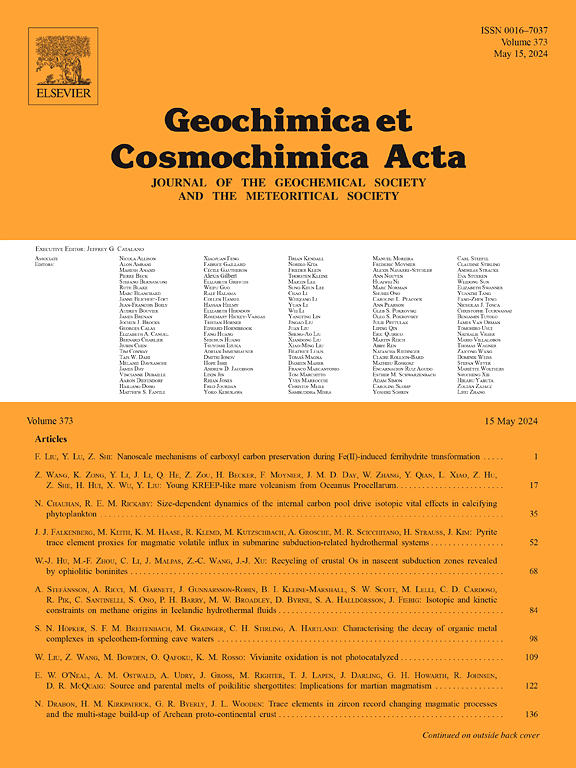The Role of Mafic Intrusions in Producing Alkaline Vent Fluids at the Lost City Hydrothermal Field: Evidence from Stable Potassium Isotopes
IF 4.5
1区 地球科学
Q1 GEOCHEMISTRY & GEOPHYSICS
引用次数: 0
Abstract
The alkaline, H2-rich vent fluids of the Lost City Hydrothermal Field (LCHF) have generally been attributed to serpentinization of tectonically uplifted mantle peridotite. However, elevated concentrations of highly incompatible and fluid mobile trace alkali metals, Rb and Cs, indicate reaction with relatively unaltered mafic components (Seyfried et al., 2015). Here, we present high-precision stable-K isotope analyses of LCHF vent fluids, which provide new constraints on source-rock lithology and support more quantitative estimates of fluid:rock ratio, providing a new constraint on heat and mass transfer processes. We find that δ41K values of LCHF vent fluids (0.03–0.07 ‰) are distinct from local seawater (0.13 ± 0.02 ‰). In combination with near-seawater concentrations of K (10.4 ± 0.1 mmol/kg), these data are incompatible with hydrothermal alteration of peridotite alone, which is highly depleted in K. Instead, K-isotope and concentration data are consistent with hydrothermal alteration of mafic rocks (e.g., gabbro or diabase) at a fluid:rock ratio of 6–26, a range that agrees well with Rb, Cs, and 87Sr/86Sr-based estimates of fluid:rock ratio, updated here to reflect derivation from mafic source rocks.
Geochemical modeling of hydrothermal fluid-rock reactions indicates that LCHF vent fluids can be effectively reproduced by a two-stage reaction in which seawater initially reacts at 200–300 °C with mafic rocks at in a fluid:rock ratio of ∼ 10 —as constrained by the above isotopic and trace-element systematics— and subsequently reacts with peridotite at a fluid:rock ratio of ∼ 30 at roughly the same temperature, pressure conditions. We also note that LCHF vent fluids are ∼ 2 % depleted in Cl compared to seawater, which may reflect admixture of a vapor component derived from ongoing phase separation at higher (> 450 °C) temperatures. We thus propose that the LCHF represents waning-stage hydrothermal activity initiated by a discrete off-axis mafic intrusion that has subsequently cooled to intermediate temperatures conducive to olivine hydrolysis and production of alkaline vent fluids. In this interpretation, alkaline H2-rich vent fields occupy a narrow thermal window in the expected evolution of hydrothermal activity associated with episodic off-axis mafic intrusions into tectonically exposed ultramafic host rocks and are thus likely to be rare on the modern seafloor.
岩浆岩侵入体在失落之城热液场产生碱性喷口流体中的作用:来自稳定钾同位素的证据
失落之城热液区(LCHF)碱性、富含 H2- 的喷口流体通常被认为是构造抬升地幔橄榄岩的蛇纹石化作用所致。然而,高浓度的高度不相容和流体流动的痕量碱金属 Rb 和 Cs 表明,它们与相对未改变的黑云母成分发生了反应(Seyfried 等人,2015 年)。在此,我们对 LCHF 喷口流体进行了高精度的稳定钾同位素分析,为源岩岩性提供了新的约束条件,并支持对流体与岩石比率进行更定量的估算,为热量和质量传递过程提供了新的约束条件。我们发现,LCHF喷口流体的δ41K值(0.03-0.07 ‰)与当地海水(0.13 ± 0.02 ‰)截然不同。结合近海水的钾浓度(10.4 ± 0.1 mmol/kg),这些数据与橄榄岩的热液蚀变不符,因为橄榄岩的钾含量极低、这个范围与基于铷、铯和 87Sr/86Sr 的流体岩石比估算值十分吻合。热液-岩石反应的地球化学模型表明,LCHF喷口流体可以通过两阶段反应有效地再现,即海水最初在200-300 °C与岩浆岩发生反应,流体与岩石的比例为10∼,这是受上述同位素和痕量元素系统学的制约,随后在大致相同的温度、压力条件下与橄榄岩发生反应,流体与岩石的比例为30∼。我们还注意到,与海水相比,LCHF喷口流体的Cl含量减少了2%,这可能反映了在较高温度(450 °C)下正在进行的相分离产生的蒸汽成分。因此,我们认为LCHF代表的是由离散的轴外岩浆侵入体引发的减弱阶段热液活动,该侵入体随后冷却到有利于橄榄石水解和产生碱性喷口流体的中间温度。根据这一解释,富含碱性 H2- 的喷口区在与构造暴露的超基性主岩中偶发的离轴岩浆岩侵入有关的热液活动预期演化过程中占据了一个狭窄的热窗口,因此在现代海底可能很少见。
本文章由计算机程序翻译,如有差异,请以英文原文为准。
求助全文
约1分钟内获得全文
求助全文
来源期刊

Geochimica et Cosmochimica Acta
地学-地球化学与地球物理
CiteScore
9.60
自引率
14.00%
发文量
437
审稿时长
6 months
期刊介绍:
Geochimica et Cosmochimica Acta publishes research papers in a wide range of subjects in terrestrial geochemistry, meteoritics, and planetary geochemistry. The scope of the journal includes:
1). Physical chemistry of gases, aqueous solutions, glasses, and crystalline solids
2). Igneous and metamorphic petrology
3). Chemical processes in the atmosphere, hydrosphere, biosphere, and lithosphere of the Earth
4). Organic geochemistry
5). Isotope geochemistry
6). Meteoritics and meteorite impacts
7). Lunar science; and
8). Planetary geochemistry.
 求助内容:
求助内容: 应助结果提醒方式:
应助结果提醒方式:


